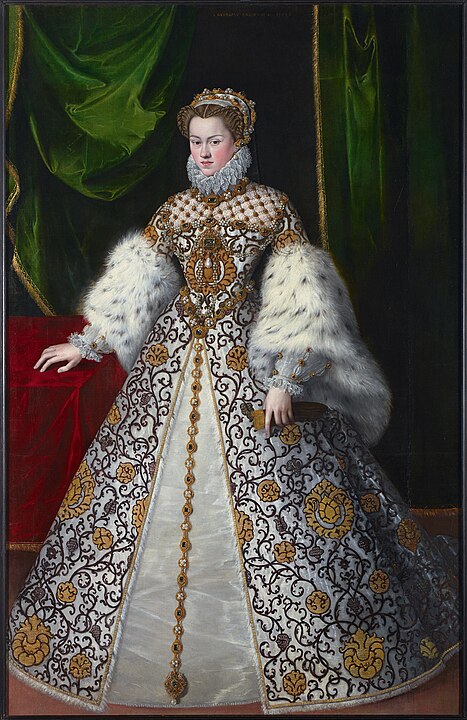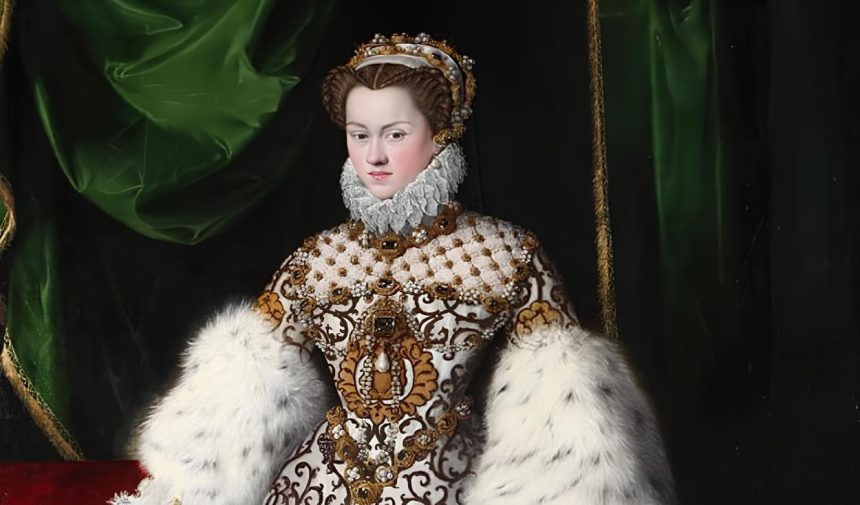Elisabeth of Austria (1554-1592), the penultimate queen of the Valois dynasty and wife of Charles IX, was a gentle and kind spouse, dominated by Catherine de’ Medici, and as unassuming as Claude and Eleanor had been; a discreet queen who is not much talked about; a queen as they were liked at that time, a queen who especially did not meddle in politics!
Elisabeth of Austria: A Younger Daughter of the Family
Charles IX came to power by officially reaching majority on August 17, 1563. Very young, malleable, and especially dominated by his mother Catherine de’ Medici, he was not well-versed in politics and governance of a kingdom.
The regent wanted peace and national independence. To achieve this, she considered an alliance with the House of Austria and opted for Anne, the eldest daughter of Maximilian II, granddaughter of Charles V.
Marshal de Vieilleville, on a mission to Vienna in 1562, found the younger Elisabeth, born in July 1554, “very pretty” and addressed the Emperor saying, “Sacred Majesty, here is the Queen of France,” and the young lady conveyed through him to the King of France “her very humble and very affectionate service”! Catherine de’ Medici received this news very coolly: Elisabeth was only a younger daughter, but an archduchess nonetheless. A Catholic marriage was still useful, and Albert de Gondi took charge of the negotiations.
The contract was signed in January 1570, and the marriage by proxy took place in October.
The young girl was sixteen and had learned to live at court, unlike all the Spanish infantas; but no one had prepared her to leave her country and especially not to learn French, as in Austria she spoke German or Spanish.
Queen of France

When she arrived in France, she was welcomed in a princely manner. Like all young future spouses, Charles IX hid in the crowd to look at her, and while waiting for her in Mézières, he “rejoiced to have found a wife to his contentment.” What did she look like? Fortunately, François Clouet made her portrait: a beautiful young girl with a triangular face, golden hair held back by a pearl headband, and a frank, direct gaze.
The official introductions took place on November 26, 1570, followed by ceremonial festivities. Elisabeth was dressed in a silver gown covered with pearls and a large purple mantle sown with golden fleurs-de-lis. She wore “an imperial crown adorned with large diamonds, rubies, and emeralds.” The festivities lasted two days, treaties were ratified, and Elisabeth became Queen of France.
The festivities in the capital took place in the spring of 1571, with triumphal arches, processions, cavalcades, fireworks, and balls. Crowned at Saint-Denis on March 25, she was “paraded” dripping with gold and pearls, in a silver cloth litter, entered Paris on the 29th, and the festivities ended on March 30, 1571, with a huge banquet and a ball offered by the City of Paris.
Of course, the Protestants were not happy to see so much money spent…
Representation and Procreation
Everything went well at the beginning of the couple’s life together: Charles IX showed her affection when she was bedridden with a bad bronchitis in January 1571; he spent time with her, brought a troupe of jugglers to entertain her, and even took her to the Saint Germain fair when she felt better. During the Carnival period, they disguised themselves and walked around Paris. But she did not have the same playful temperament as him and especially did not speak the same language: there was a total misunderstanding! When someone addressed her, they had to go through the Countess of Arenberg, a lady in her retinue who acted as a translator. After a year of marriage, she was pregnant… and despite Marie Touchet (the king’s mistress), Elisabeth “never showed him a worse face, nor said a worse word to him, patiently enduring her little jealousy and the theft he was making from her.”
Raised in virtue and religion, she supported her husband during the dark hours of St. Bartholomew’s Day. Locked alone in her apartments, almost alone sleeping in the Louvre, when the tocsin began to ring, and her women warned her to tell her that her husband was responsible, she began to pray for him and ask God to forgive him!
On October 27, 1572, a little Marie-Elisabeth was born, carried by the godmother, the Queen of England, during the baptism.
Elisabeth is mentioned once again during the visit of the Polish ambassadors in 1573: she only makes an appearance. During the three and a half years of reign, she is sidelined by her husband, who prefers hunting, and her mother-in-law, who prefers power. However, when her husband is ill, she stays by his side, sitting in silence, crying while hiding her pain, praying a lot, even at night so as not to be seen.
Elisabeth of Austria’s Return to Vienna
After her husband’s death in 1574, “not being recognized or rewarded as she deserved,” she was resolved to return to Austria, unable to stay in France because she had no son. In Amboise, she went to embrace her little daughter, whom she would never see again and who would die in April 1578, then left Paris in early December 1575. She settled again in Vienna; she was only twenty-one years old! She remained on good terms with her sister-in-law Marguerite (Queen Margot), to whom she would pay half of her dowry when she learned that the Queen of Navarre no longer had “a penny to her name.”
Henry III was considered as her new husband: she refused; Philip II of Spain had just lost Anne (the eldest of the archduchesses), Elisabeth was proposed to him: she refused again, in memory of her husband Charles.
Wishing to enter a convent, she founded a monastery of Poor Clares near Vienna. There she led the life of nuns “in vigils, fasts, and continuous prayers for Peace among Christian princes.” She created the Church of All Saints in Prague and may be the origin of two works “on the Word of God” and “on the considerable events that occurred in France in her time.”
She died in January 1592, and L’Etoile wrote, “she had been greatly loved and honored by the French.”


